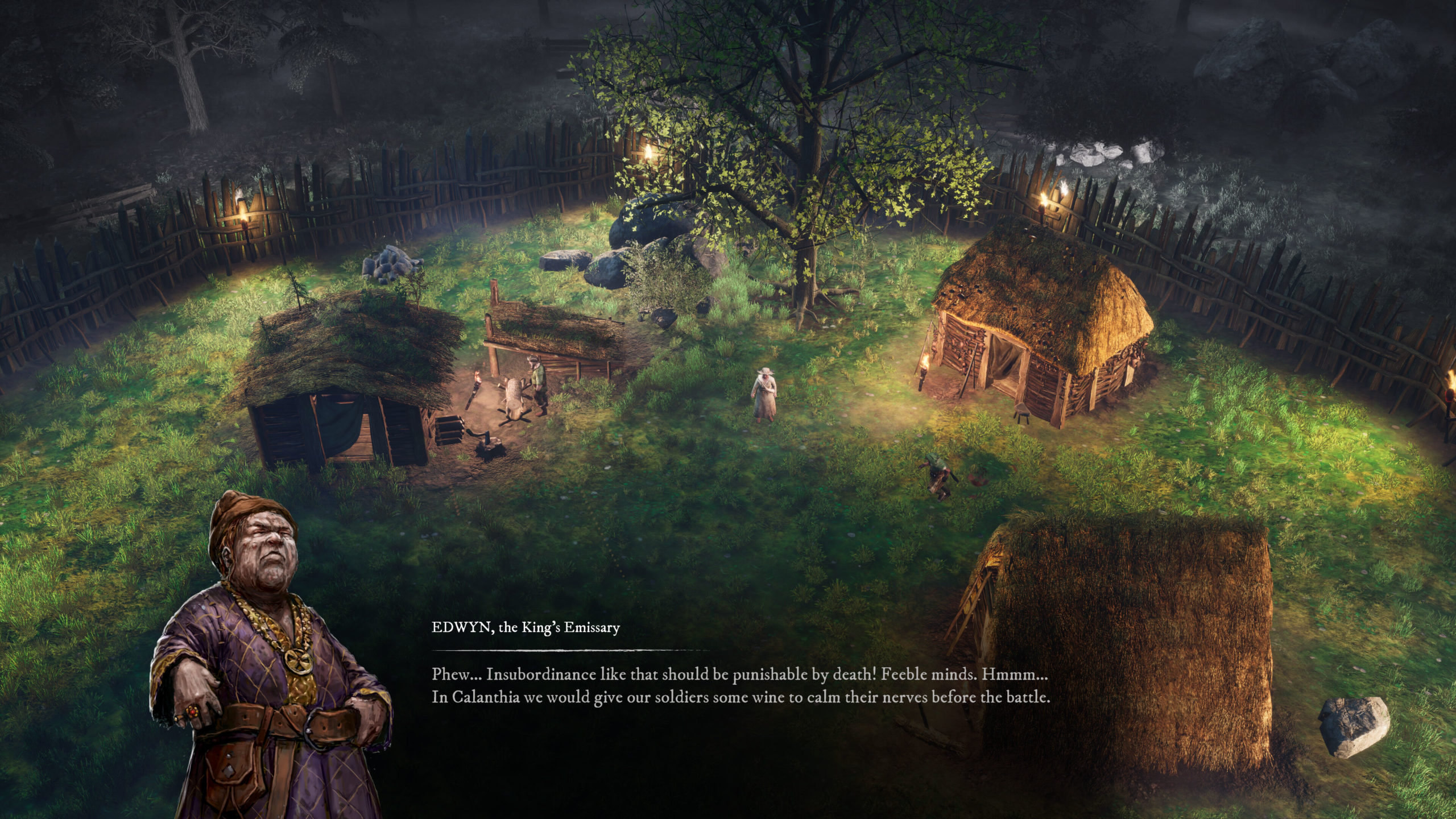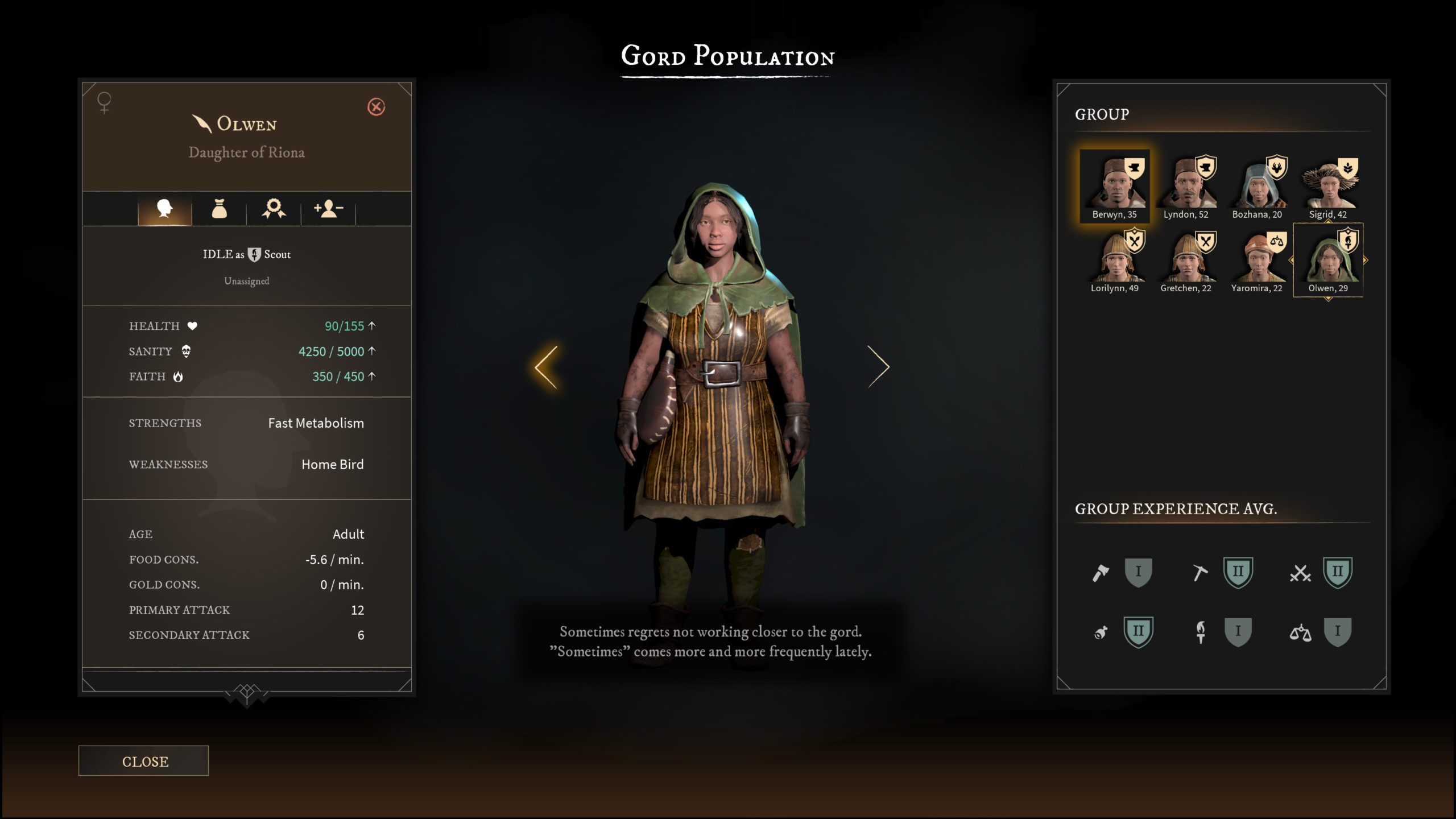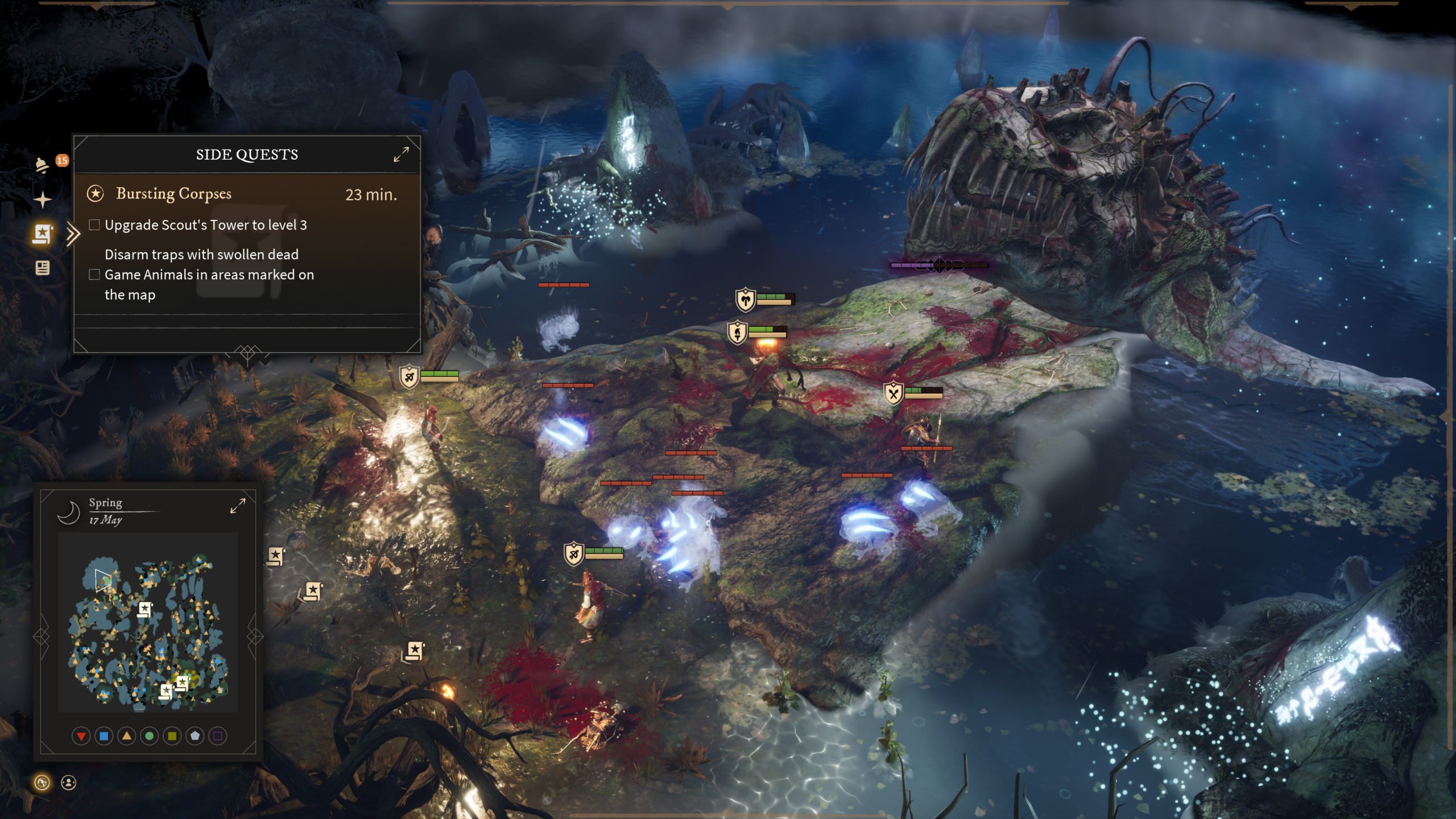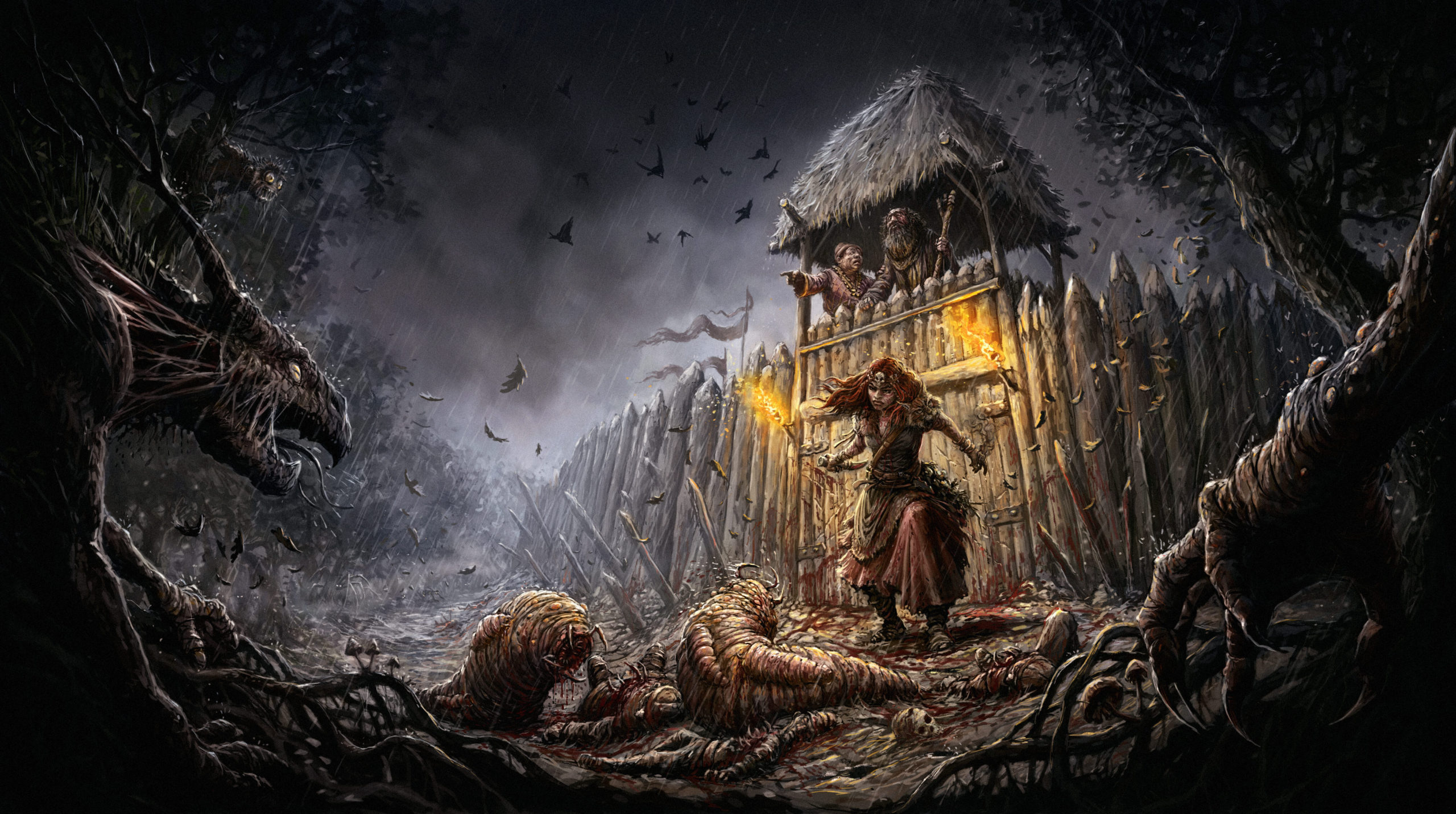I didn’t really know what to expect when I booted up Gord for the first time. A mix of colony sim and survival game smashed together into a Witcher-inspired world is a recipe for one heck of an RTS burger. Dripping with a dark, brooding atmosphere and the promise of outlasting the elements in a challenging environment, Gord leaves a daunting first impression.
If you’re wondering what a Gord even is: effectively it’s a smattering of wooden houses surrounded with palisades and a ring-shaped fence. Nifty, right? As a concept, it fits the colony and survival themes pretty well. Which begs the question of whether this translates into a structure worth defending or if it burns itself down from the fire of a single match.
Man your lookout towers and batten down the gates, there’s a hellish swamp to endure. Is this a Gord worth protecting?
With Gord On Their Side
The premise of Gord is rather straightforward, whether it’s “good” or not is a bit more complicated. Following the ascension of the king in this land, who is pushing to expand their own sphere of influence, you are a steward tasked with paving the way for their army. To do so, you’ll take charge of a smaller tribe currently inhabiting a rather cursed, decrepit and rather dank swamp.
Gord sets up a couple of villainous figures in the king’s representative, a hostile faction named the Red Horde and another tribe who contest your expansion into their lands. While it attempts an extra layer or two of story, it all falls a bit flat. The Red Horde for example are built up to be a formidable foe, only for the conclusion to end in a tepid cutscene.
Similarly, there’s a semblance of personal drama wrapped around your tribe’s leader and a mysterious witch lady, but it’s just rather uninteresting to follow. It’s fairly well voiced, but the connection is undermined in how characters look at the camera to talk to the “steward” despite you having no physical presence whatsoever. It’s strangely jarring and that sums up quite a lot of Gord’s narrative efforts.
There are some interesting tidbits in here and in some ways, the game focuses more on the mini-stories you forge for yourself in your tribespeople. However, that doesn’t always save it from being a bit run-of-the-mill and lackluster in places. A decent effort I certainly didn’t dislike, but the stakes feel underwhelming and the narrative pay-off is as disappointing as finding a box of chocolates only filled with wrappers.

Gord Awful Feel To The Place
Despite the story having more chips in the woodwork than a student house’s skirting boards, the ex-Witcher dev experience shines through in Gord’s atmosphere. Across the various biomes you’ll need to scavenge and battle your way through, there’s a constant aura of menace and threat. The light of your tribe’s torches only just piercing the enveloping darkness, offering a slither of sanctuary.
It’s a very effective graphical setup. When you stumble into a corrupted area of the map or have to chart your way through the fog of war, Gord feels positively unnerving. Unlike many other games, exploration feels daunting. The game isn’t anything spectacular in terms of visual spectacle, but it feels like the team have taken the Velen section of The Witcher 3 and turned it into an entire map just for this game.
Creatures are dangerous and aggressive, your townsfolk are relatively flimsy and withered. Everything culminates in an arresting style that kept me interested throughout my time with the game. It has some flaws, like a couple of broken animations or troublesome pathfinding, but there’s a lot more to like than dislike here.
Elements of the HUD and interface can be troublesome, like how the game never tells you how to upgrade buildings properly (hint: press down on the D-pad). Additionally, your people will just outright ignore your commands if in the middle of an animation, as for some reason, Gord won’t queue commands, which is annoying.

Knights Of The Unholy
Commanding your tribe through this unadulterated hellhole of a locale is the name of the game however. As steward, you’re tasked with setting up a a new camp across Gord’s 10 campaign levels in order to achieve their next objective. The setup is almost universally the same: build up your gord, gather resources, recruit some soldiers and venture forth.
The base-building elements of Gord are fairly basic: a handful of standard resource gathering options, a special buildings menu for unique buildings like a temple and militaristic structures. Members of your tribe can be assigned to each role at will, giving flexibility to their service in the tribe. However, while you can maximise their output based on their stats, you never truly need to.
Which does create a bit of a problem: I never truly cared about my individual tribespeople. While it was great to be able to swap Reinnalt from a reeds-gatherer to a scout at any moment, it meant he lacked a sense of personality. Given that Gord is very focused on atmosphere and keeps your clan’s size rather small, it seems like a missed opportunity to not create more unique citizens. This is especially pertinent, given you can transfer units between missions.
Your subjects will perform their roles automatically, provided you’ve allocated them to a structure. Gord is a good example of a streamlined RTS that functionally is sound, even on console. Aside from the fact they run head-first into danger when scrounging the environment, they’re fairly self-sufficient. The interface is a bit clumsy at first, but grows into a more intuitive affair after a couple of missions. Moreover, having every unit on the side provides you all the information you need on their wellbeing, which is great.

The Fogs Of War
As I mentioned earlier, the world around your gord is positively bereft with dangers. At the start of any scenario, you’ll need to clear safe haven areas of enemies to scavenge in safety. Once you’ve developed your basic structures, you’ll have to scour the map to find rarer resources like clay, iron or gold to upgrade and upkeep the units you’ll need for combat.
Most missions boil down to go to this designated point, kill everything in the way, gather so many resources, complete. On a couple of scenarios, you’ll need to appease or battle through a Horror: a creature formed of evil. From demanding the sacrifice of a child (yes, really) to commanding you build a statue in their honour, they’re an expectant lot. They provide a welcome bit of variety, as battling them is very tough. If you ignore them, they’ll curse your tribe, making your playthrough that much harder too.
I like Gord’s gameplay loop a lot. The act of establishing your pallisade, creating safe zones with Firefly braziers, venturing out to explore an unwelcoming land, it’s great. However, it never truly develops beyond the first few levels. While new incantations (powerful spells) are unlocked as you progress, not much else really is.
Strangely, past mission four or five, raids on your gord just stop occurring. They’re a dynamic element that create a push-and-pull of making you wary of over-committing units to excursions. But after a story event occurs, I never had to worry about them again. This made later missions a breeze, as I just cleared initial areas with one or two rivers, hoovered up resources, amassed a force and trudged onto the objective.
The campaign becomes less interesting as it develops as a result. The first few levels providing a satisfying challenge and a constant feeling of being overwhelmed. Then, the later half becomes a bit of a bore, offering little other than basic base-building. You have to rebuild a new gord in every scenario too, so repeating the act of setting up the initial structures nine times becomes less interesting with each attempt.

UnGordly Yet Not Unworthy
To its credit, Gord does add some dynamic elements to its gameplay formula. Side quests will infrequently provide you with the odd task. Random events can impact your tribespeople with positive boosts or harrowing losses. Blood moons will drastically increase the risk of the map and you may stumble on a number of stat enhancing boons or items.
The campaign is a chunky affair, taking me roughly 15 hours to see through to completion. You can create custom scenarios with a variety of win conditions and sliders for everything from starting resources to what Horror you’ll encounter, too. Custom scenarios provide more variety to the usual story setups, providing some welcome longevity to the game’s offering.
While it never quite captured me in the throngs of its gameplay depth and host of random, if minor, issues, Gord’s atmosphere and sense of world-building is genuinely excellent. I enjoyed the initial challenge of getting to grips with its demands, where the game is at its best when it’s pushing you from all sides at once.
The campaign doesn’t quite sustain that level of intrigue, but there’s more than enough in the accessible RTS systems to make it a worthy venture. Especially on console, the game functions surprisingly smoothly and bar the odd framerate dip, it performs well too. This swamp is certainly a daunting vacation ground, but why spend your holiday in the sun when you can appease a demonic Horror with a blood sacrifice?
Despite a flimsy narrative and gameplay quirks, Gord has a stellar sense of atmosphere and a haunting presentation inspired by the ex-Witcher talent in the team. It functions well for a console RTS title and while it doesn’t quite have the depth of other base-building games, it’s got enough challenge and wonder to keep you interested till the end. Maybe even a couple of custom scenarios too.

Gord will be releasing on August 17th for PlayStation 5, Xbox Series X|S and PC via Steam.
Developer: Covenant.dev
Publisher: Team17 Digital
Disclaimer: In order to complete this review, we were provided with a promotional copy of the game. For our full review policy, please go here.
If you enjoyed this article or any more of our content, please consider our Patreon.
Make sure to follow Finger Guns on our social channels. Twitter, Facebook, Twitch, Spotify or Apple Podcasts – to keep up to date on our news, reviews and features.
